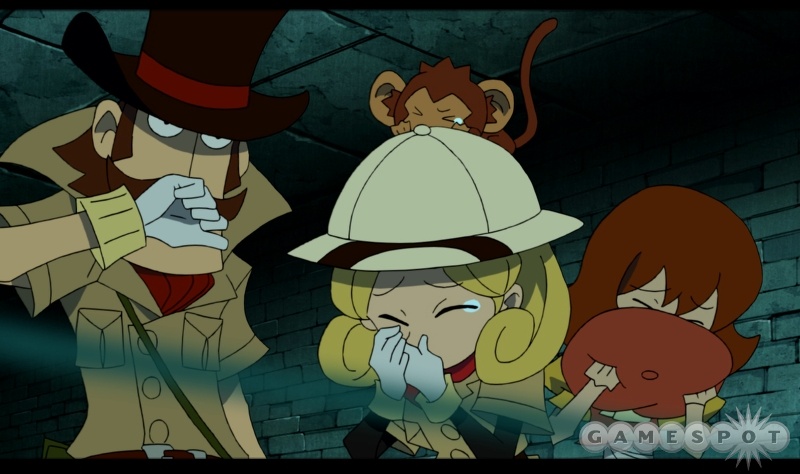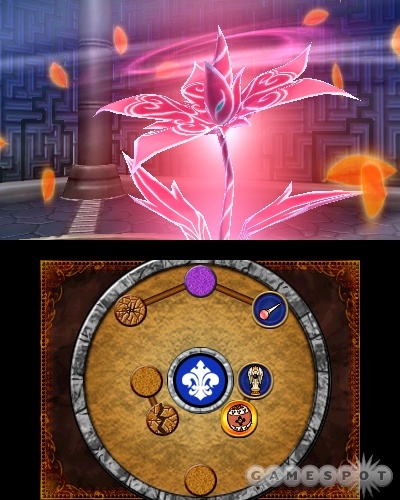E3 2011: Doctor Lautrec and the Forgotten Knights Exclusive Preview
We put our treasure-hunting skills to the test beneath the city of Paris in this upcoming puzzle adventure game.
Konami's Doctor Lautrec and the Forgotten Knights may share similarities with Level-5's Professor Layton series, but you shouldn't write this off as a clone, because it actually plays out quite differently. Sure, you have the smart man with the top hat who's all about pursuing the truth, and a somewhat annoying sidekick--and, of course, the puzzles, and it's set in Europe--but Doctor Lautrec has plenty of gameplay variety and depth that make it stand out on its own.
The Complete FALLOUT Timeline Explained! Warhammer 40k: Darktide - Path of Redemption | Update Trailer Is Fallout 76 Good in 2024? SAND LAND - Official Darude Sandstorm Trailer No Rest for the Wicked - Official Steam Early Access Launch Trailer Battlefield 2042 | Frontlines Mode Returns - Time-Limited Event Trailer 21 Details You May Have Missed In Helldivers 2 Stellar Blade - Official "The Journey" Behind The Scenes Trailer | PS5 Games Zenless Zone Zero - Official Koleda Character Teaser Trailer | "Bite At The Site" PUBG MOBILE | SPYxFAMILY Collaboration LIVE Now! Genshin Impact | Version 4.6 "Two Worlds Aflame, the Crimson Night Fades" Trailer The 11 Creepiest Vaults Of Fallout
Please enter your date of birth to view this video
By clicking 'enter', you agree to GameSpot's
Terms of Use and Privacy Policy
The game is being developed by Konami and Winkysoft, and Noriaki Okamura (Metal Gear Solid: Portable Ops) is the lead designer on the project. Doctor Lautrec is a blend of different gameplay styles, so if you're just looking for one puzzle after another, then you're out of luck. During our brief hands-on time with the game, we not only solved puzzles, but had to sneak around to avoid guards, fight treasure guardians (we'll get into that later), and had the freedom to explore the historically rich city of Paris in the late 19th century.
On top of the varied gameplay, there are several looks to the game. There are fully animated and voice-acted cutscenes that unfold like an anime, and there are in-game 3D modeled scenes as well. During the longer dialogue exchanges between two people, the visuals reverts to cartoony 2D character portraits, also fully voice-acted. Having the system's 3D slider all the way up doesn't seem to make a huge difference, especially during the 2D cutscenes, but the game does look more interesting when it switches to 3D models. With 3D on, items and the 2D animation will pop out a little, and you'll get more depth when you're walking around town.
The game starts off underground, where you're following the archeologist Lautrec and his assistant, Sophie, as they crawl through the passageways beneath the Arles Amphitheatre located in the southern part of France. Here you'll get a sense of the interaction between the two and perhaps start to feel a bit claustrophobic as they head further in. Sophie is the chatty one and asks a lot of questions, while the doctor is the strong silent type who just wants to get things done. We're also introduced to Gustav, Lautrec's archnemesis, and the not-so-friendly inspector Godot, who is looking for a reason to get the archaeologist behind bars. It seems that the doctor isn't very popular, but his antagonistic attitude might have something to do with it.

Without going into too much detail regarding the story, once we were able to control Lautrec, our first order of business was to get through the underground passage and avoid being seen by patrolling guards. Using the analog stick, we just had to avoid their line of sight and not get too close. This part is in the third-person, and you can hold the B button and move the D pad to scan ahead. If we got caught, we were sent back to the beginning. It was a similar situation in the next room; however, this time we had to use the A button to move large boxes out of the way. This part wasn't very complicated, and you can reset and start from the entrance, but judging from the tutorial (which comes up every time you're introduced to something new), it looks like there will be box pushing/pulling in our future.
The first puzzle we came across involved arranging a list of words in a crossword puzzle. You're given three hints, which will decrease the number of reputation points you earn, but they're there if you need them. The puzzles weren't too difficult at this stage, but what sets this puzzle game apart is what came next. When Sophie and the doctor stumbled across a large room brimming with gold and a peculiar egg-shaped gem in the middle, they were careful in how they approached it. Apparently, humanoid spirits inhabit these artifacts ("treasure animatus," or living treasure) and will attack you once you get close. These treasure guardians can be tamed by using spirits you've already collected from previous treasure animatus. The battle is a turn-based affair, with the spirit on the top screen and your pedestals on the bottom screen. You place treasure from your inventory on the pedestals to attack, and you are limited to three at any point in time. Cracked pedestals onscreen will yield a random effect. A meter indicates the guardian's health, and to tame it, you have to bring it down to the blue meter without killing it. (If you do kill it, it can be revived.) Each guardian has a different property--avian, terrestrial, or aquatic--and these properties function in a rock-paper-scissors sort of way, where each element has a weakness and an advantage over another.
After the fight (the game takes over at this point), it's clear that the police officers were hot on our trail, so we skedaddled. The story really begins after that: Sophie and the doctor are reading quietly in the office when they are interrupted by a knock on the door. Here they meet Marie, a young lady who possesses an incredibly valuable item that could lead to the lost treasure of the Bourbon Dynasty. Unfortunately, she is accompanied by Jacques-Marie Vidocq, whose goal is to steal it. After being chased around the city, we made our way beneath the Parisian opera house. Below the glitz and glamor is seedy bar where adventurers gather for news and to stay out of the sunlight.

Here we were able to take control again and roam the streets of Paris. At the opera house you can look up quests, as well as purchase items with the reputation points you've earned from solving puzzles. Quests will yield more treasure animatus, and though you can carry only three at any given time, collecting more will give you more options to play with when facing a harder guardian. From what we've played, the early part of the game certainly got our attention with all the different things we could do. Not only that, but the frequent cutscenes were a great way of moving the story forward and kept things exciting, and the characters, while exaggerated, are lively and entertaining. We'll have to see if that keeps up as we go further into the game. We hope to have more for you in the coming months before Doctor Lautrec and the Forgotten Knights is released this summer.
Got a news tip or want to contact us directly? Email news@gamespot.com
Join the conversation